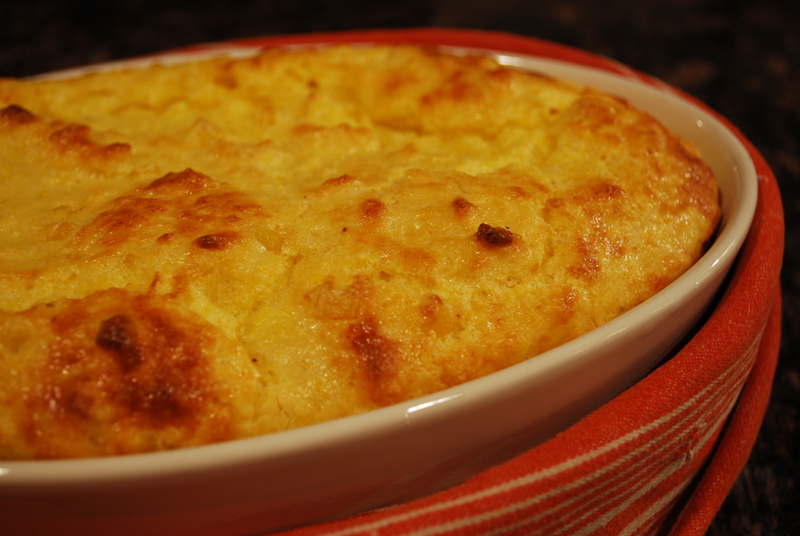Week Seven: American Breads

There’s a major trend in the culinary world right now, one that involves taking formerly-uncool or home-style foods, and elevating them to fine-dining standards. Think s’mores to follow your duck à l’orange, macaroni and cheese with cave-aged gruyere and house-made pasta, or hamburgers topped with foie gras. Need I even mention the revival of fondue? In this same vein, the once lowly spoonbread has been making a welcome resurgence, at least in fine Southern restaurants.
There was once a time when you would only find spoonbread in the occasional Southern kitchen, far less often than you would see its simpler cousin, cornbread. Spoonbread is a sort of cross between cornbread, polenta, a soufflé, and corn pudding. Properly made, it has an almost custardy interior, a crunchy crust, and is wonderfully soft and fluffy throughout. It is leavened with whipped egg whites, which is why it takes a little more work than a standard cornbread.
Certainly, this unusual blend of qualities is part of what has enticed such Southern toques as Frank Stitt to include the humble spoonbread on their menus. After all, when you’re turning out the most heavenly plates of Carolina quail with wild mushroom and hominy stuffing, or impeccable Gulf shrimp over local stone-ground grits, what’s whipping up a little spoonbread on the side? Another part of the reason for its renaissance is that these chefs, raised on bacon grease and biscuits, could no longer overlook the odd gap between what they ate at home and what they cooked at work. Who’s to say that a good spoonbread can’t stand up to the most perfect savory French soufflé? No one, that’s who. Both light and fluffy, picking one over the other would be like picking children.
Spoonbread once was actually far more popular than cornbread, because of this lightness. Fluffy cornbread relies on baking powder for its lift; without it, it is a dense, grainy thing. But since baking powder wasn’t around before the mid-1800s, cooks had to rely on eggs to provide lift in corn-based breads. And since wheat agriculture had yet to really take off in America, corn was basically it for grain. So, rather than choke down pancake after pancake of flat johnnycakes, many cooks opted to mix a cooked cornmeal mash with whipped eggs, producing a soft and light bread, one that you could even eat with (oh, yes) a spoon. But with the advent of baking powder, a better cornbread could be made far more quickly than eggs could be whipped. Spoonbread fell to the wayside, a culinary relic brought out for special occasions, often dressed up with cheese and whole corn kernels. But thanks to those Southern chefs who are bringing the food of their mommas (and their momma’s mommas) to some of the finest tables in the nation, you may just see some spoonbread on a menu soon.
So, is this even a bread? Is it a soufflé? Is it a pudding? But really, does it matter? The way I figure, it’s a kissing cousin to cornbread, which itself is definitely a bread; plus it even says the word “bread” in its name. It’s starchy and baked and fabulously good, and that’s close enough for me. I hope you’ll agree!
Spoonbread
Makes 6-8 servings
2 1/2 cups milk
2 tablespoons unsalted butter
1 teaspoon salt
1 cup cornmeal
3 large eggs, separated
1/8 teaspoon cream of tartar (optional)
1/2 cup cream
3-5 dashes hot sauce
1 large pinch cayenne
1/2 cup grated sharp cheddar cheese
3/4 cup corn kernels (optional)
1. Position a rack in the center of the oven. Preheat the oven to 375ºF. Grease an 8×8 inch baking pan, or a large soufflé dish.
2. In a large, heavy saucepan, bring the milk, butter, and salt to a simmer over medium heat. Reduce the heat to low, and add the cornmeal in a slow, steady stream, whisking constantly to prevent lumps.
3. Increase the heat to medium and cook, stirring constantly until the mixture is thick and shiny, 3 to 4 minutes. Remove from the heat and set aside to cool for 3 or 4 minutes.
4. Whisk egg yolks and cream together. Add cheese, hot sauce, and cayenne. Stir gradually into the cornmeal mixture. Add corn kernels.
5. Beat egg whites and cream of tartar in a mixer on medium speed until the peaks are slightly stiff but not dry. Fold one-third of the egg whites into the cornmeal mixture to lighten it, then gently fold in the remaining whites.
6. Scrape the batter into the prepared baking dish and spread evenly. Bake until the bread has risen like a soufflé, with a golden brown surface, and a knife inserted in the center comes out clean, 25 to 35 minutes. Serve immediately.
Notes:
1. If you like, you can add some chopped green onions at the same time as the corn kernels. Corn and scallions are so good together!
2. You can use either fresh, frozen, or canned corn kernels. If you have them frozen, add them to the still-hot cooked cornmeal mixture to thaw them a little.
3. This recipe can apparently take to any amount of ingredient-tweaking. I found recipes for spoonbread that varied wildly in the amount of milk, corn meal, and eggs used. Some used buttermilk, others added cheese, some omitted both. The recipe I’ve given above will produce a fairly loose end product; if you like it a little thicker (more bready), try omitting the cream added to the egg yolks (step 4). If you like it a little more soufflé-like, add more eggs. Don’t expect to be able to serve a slice like a piece of bread, though; spoonbread should be too soft to eat with your hands.
4. Traditionally, spoonbread never has sugar in it. If your spoonbread includes sugar, you’d best be calling it “corn pudding”!

